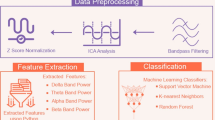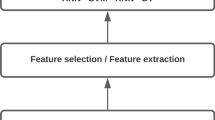Abstract
Functional Magnetic Resonance Imaging (fMRI) is the popular technique where it is possible to capture neural activity in brain regions when subjected to different stimuli. However, due to fMRI datasets' high dimensional and sparse nature, the best features' selection plays an essential role in providing the best classification accuracy in fMRI models. This paper selects the stable feature set from the fMRI dataset using hybrid Fast Fourier Transform with Particle Swarm Optimization and Genetic Algorithm (FFTPSOGA). Fast Fourier Transform (FFT) is used on the extracted features by PSO-GA to convert the magnitude of features into phase values for better performance. Next, the machine learning algorithms of GaussianNB, Support Vector Machine (SVM), and XGboost has been trained based on these extracted features of six subjects of the dataset. The experimental analysis reveals that the proposed algorithm resulted in optimum features that helped extract informative Regions of Interest (ROI) with better classification accuracy. Our implemented algorithm FFTPSOGA extracted the best voxels in six subjects of the dataset by selecting minimum ROIs with a model classification accuracy of 0.98, 0.95, 0.95, 0.95, 0.97, and 0.96 for the SVM classifier. Comparison of the proposed scheme with state-of-the-art techniques show that our algorithm resulted in best voxels and outperformed work in [1, 9, 25] by achieving higher accuracy of 98% and low computational costs with only 127 number of features. Due to its better performance, we believe that it can be used for the pattern identification of brain responses in multi-subject fMRI data.












Similar content being viewed by others
Data availability
The data used for carrying out experiments in this research contains multi-subject fMRI data of 6 persons and is available online at http://www.cs.cmu.edu/afs/cs.cmu.edu/project/theo-81/www/.
References
Albalawi F, Alshehri S, Chahid A, Laleg-Kirati T (2020) M “voxel weight matrix-based feature extraction for biomedical applications”. IEEE Access 8:121451–121459
Anter AM, Wei Y, Su J, Yuan Y, Lei B, Duan G, Fu Z (2019) A robust swarm intelligence-based feature selection model for neuro-fuzzy recognition of mild cognitive impairment from resting-state fMRI. Inf Sci 503:670–687
Bhatti UA, Huang M, Wu D, Zhang Y, Mehmood A, Han H (2019) Recommendation system using feature extraction and pattern recognition in clinical care systems. Enterprise Inform Syst 13(3):329–351
Bhatti UA, Yu Z, Chanussot J, Zeeshan Z, Yuan L, Luo W, Mehmood A “Local Similarity-Based Spatial–Spectral Fusion Hyperspectral Image Classification with Deep CNN and Gabor Filtering”. IEEE Trans Geosci Remote Sens, vol. 60, pp. 1-15, 2021.
Chen JE, Glover GH (2015) Functional magnetic resonance imaging methods. Neuropsychol Rev 25(3):289–313
Cohen JD, Daw N, Engelhardt B, Hasson U, Li K, Niv Y, Norman KA et al (2017) Computational approaches to fMRI analysis. Nat Neurosci 20(3):304–313
Eklund A, Andersson M, Knutsson H (2012) fMRI analysis on the GPU—possibilities and challenges. Comput Methods Prog Biomed 105(2):145–161
Erhardt EB, Rachakonda S, Bedrick EJ, Allen EA, Adali T, Calhoun VD (2011) Comparison of multi-subject ICA methods for analysis of fMRI data. Hum Brain Mapp 32(12):2075–2095
Fan M, Chou CA (2016) Exploring stability-based voxel selection methods in mvpa using cognitive neuroimaging data: a comprehensive study. Brain Inform 3(3):193–203
Fang Y, Liu J, Li J, Cheng J, Hu J, Yi D, Bhatti UA (2022) Robust zero-watermarking algorithm for medical images based on SIFT and Bandelet-DCT. Multimed Tools Appl 81(12):16863–16879
Ghamisi P, Benediktsson JA (2014) Feature selection based on hybridization of genetic algorithm and particle swarm optimization. IEEE Geosci Remote Sens Lett 12(2):309–313
Jin B, Strasburger A, Laken SJ, Kozel FA, Johnson KA, George MS, Lu X (2009) Feature selection for fMRI-based deception detection. BMC Bioinform 10(9):1–7 BioMed Central
Kassraian-Fard P, Matthis C, Balsters JH, Maathuis MH, Wenderoth N (2016) Promises, pitfalls, and basic guidelines for applying machine learning classifiers to psychiatric imaging data, with autism as an example. Front Psychiatry no. 7:177
Kauttonen J, Hlushchuk Y, Tikka P (2015) Optimizing methods for linking cinematic features to fMRI data. Neuroimage 110:136–148
Korhonen O, Saarimäki H, Glerean E, Sams M, Saramäki J (2017) Consistency of regions of interest as nodes of fMRI functional brain networks. Network Neurosci 1(3):254–274
Lahiri R, Rakshit P, Konar A (2017) Evolutionary perspective for optimal selection of EEG electrodes and features. Biomed Signal Process Control 36:113–137
Liu J, Ji J, Jia X, Zhang A (2019) Learning brain effective connectivity network structure using ant colony optimization combining with voxel activation information. IEEE J Biomed Health Inform 24(7):2028–2040
Ma X, Chou CA, Sayama H, Chaovalitwongse WA (2016) Brain response pattern identification of fMRI data using a particle swarm optimization-based approach. Brain Inform 3(3):181–192
Metawa N, Hassan MK, Elhoseny M (2017) Genetic algorithm-based model for optimizing bank lending decisions. Expert Syst Appl 80:75–82
Michel V, Damon C, Thirion B (2008) Mutual information-based feature selection enhances fMRI brain activity classification. In: In 2008 5th IEEE international symposium on biomedical imaging: from nano to macro. IEEE, pp 592–595
Mirzaei S, Soltanian-Zadeh H (2019) Overlapping brain community detection using Bayesian tensor decomposition. J Neurosci Methods 318:47–55
Ota K, Oishi N, Ito K, Fukuyama H (2015) Sead-J study group, & Alzheimer's disease neuroimaging Initiative. “Effects of imaging modalities, brain atlases and feature selection on prediction of Alzheimer's disease”. J Neurosci Methods 256:168–183
Paul S, Das S (2019) Simultaneous feature selection and weighting–an evolutionary multi-objective optimization approach. Pattern Recogn Lett 65:51–59
Poldrack RA (2012) The future of fMRI in cognitive neuroscience. Neuroimage 62(2):1216–1220
Ramakrishna JS, Ramasangu H Classification of cognitive state using clustering based maximum margin feature selection framework”, In 2017 International Conference on Advances in Computing, Communications and Informatics (ICACCI), pp. 1092-1096. IEEE
Rashid M, Singh H, Goyal V (2020) The use of machine learning and deep learning algorithms in functional magnetic resonance imaging—a systematic review. Expert Syst 37(6):e12644
Satoru HIWA, Kohri Y, Hachisuka K, Hiroyasu T (2016) Region-of-interest extraction of fMRI data using genetic algorithms. In: In 2016 IEEE symposium series on computational intelligence (SSCI). IEEE, pp 1–7
Sengupta S, Basak S, Peters RA (2019) Particle swarm optimization: a survey of historical and recent developments with hybridization perspectives. Mach Learn Knowl Extrac 1(1):157–191
Serra A, Galdi P, Tagliaferri R (2018) Machine learning for bioinformatics and neuroimaging. Wiley Interdisciplinary Rev: Data Mining Knowl Discov 8(5):e1248
Shahamat H, Pouyan AA (2015) Feature selection using genetic algorithm for classification of schizophrenia using fMRI data. J AI Data Mining 3(1):30–37
Shi Y, Zeng W, Wang N, Zhao L (2018) A new constrained spatiotemporal ICA method based on multi-objective optimization for fMRI data analysis. IEEE Trans Neural Syst Rehab Eng 26(9):1690–1699
Sidhu G (2019) Locally linear embedding and fMRI feature selection in psychiatric classification. IEEE J Trans Eng Health Med 7:1–11
Smith SM, Hyvärinen A, Varoquaux G, Miller KL, Beckmann CF (2014) Group-PCA for very large fMRI datasets. Neuroimage 101:738–749
Song Y, Wang F, Chen X (2019) An improved genetic algorithm for numerical function optimization. Appl Intell 49(5):1880–1902
Sumanaweera T, Liu D (2005) Medical image reconstruction with the FFT. GPU Gems 2:765–784
Tian D, Shi Z (2018) MPSO: modified particle swarm optimization and its applications. Swarm Evol Comput 41:49–68
Tom Mitchell WW: Starplus fmri data. http://www.cs.cmu.edu/afs/cs.cmu.edu/project/theo-81/www/
Wang Y, Ji J, Liang P (2016) Feature selection of fMRI data based on normalized mutual information and fisher discriminant ratio. J X-ray Sci Technol 24(3):467–475
Xu W, Li Q, Liu X, Zhen Z, Wu X (2020) Comparison of feature selection methods based on discrimination and reliability for fMRI decoding analysis. J Neurosci Methods no. 335:108567
Yang Z, Zhuang X, Sreenivasan K, Mishra V, Cordes D, Initiative A's DN (2020) Disentangling time series between brain tissues improves fMRI data quality using a time-dependent deep neural network. NeuroImage no. 223:117340
Young KS, Maj A, van der Velden MG, Craske KJ, Pallesen LF, Roepstorff A, Parsons CE (2018) The impact of mindfulness-based interventions on brain activity: a systematic review of functional magnetic resonance imaging studies. Neurosci Biobehav Rev 84:424–433
Zeng C, Liu J, Li J, Cheng J, Zhou J, Nawaz SA, Bhatti UA (2022) Multi-watermarking algorithm for medical image based on KAZE-DCT. J Ambient Intell Human Comput:1–9
Author information
Authors and Affiliations
Corresponding author
Ethics declarations
Conflicts of interest
The authors declare no conflict of interest.
Additional information
Publisher’s note
Springer Nature remains neutral with regard to jurisdictional claims in published maps and institutional affiliations.
Rights and permissions
Springer Nature or its licensor (e.g. a society or other partner) holds exclusive rights to this article under a publishing agreement with the author(s) or other rightsholder(s); author self-archiving of the accepted manuscript version of this article is solely governed by the terms of such publishing agreement and applicable law.
About this article
Cite this article
Rashid, M., Singh, H. & Goyal, V. FFTPSOGA: Fast Fourier Transform with particle swarm optimization and genetic algorithm approach for pattern identification of brain responses in multi subject fMRI data. Multimed Tools Appl 82, 45433–45452 (2023). https://doi.org/10.1007/s11042-023-15471-1
Received:
Revised:
Accepted:
Published:
Issue Date:
DOI: https://doi.org/10.1007/s11042-023-15471-1




